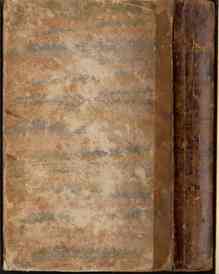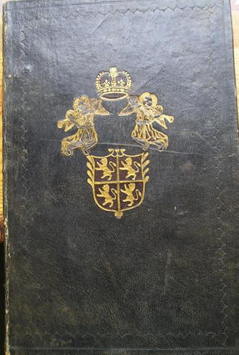Above: Howard Rice surrounded by Sylvia Beach’s personal papers, office files, and the sign for Shakespeare & Co., 31 March 1964. At left: Her desk and some books, 12, rue de l’Oléon, 31 March 1964.
When Sylvia Beach died in 1962, relict in her apartment were books, business papers, correspondence, photographs, paintings, and literary memorabilia. By agreement with her sister, Holly Beach Dennis, Princeton purchased these effects in early 1964. Associate librarian for special collections, Howard C. Rice arrived in Paris in late March and spent three weeks in the rooms over her famous bookshop, Shakespeare and Company, 12, rue de l’Oléon.
Even though Sylvia Beach had given away 5,000 books to the American Library in Paris in 1951 (New York Herald Tribune, April 25, 1951) and even though she had sold her ‘Joyce Collection’ (as she called it) to the University of Buffalo in 1959, the apartment held, counting just the books, according to her sister’s lawyer, Richard Ader, 8,000 to 10,000 volumes. Untold numbers of papers and other objects filled closets, shelves, and walls. Howard Rice described as a ‘struggle’ his efforts to sort, collocate, organize, pack, and arrange shipping or further disposition of the apartment’s contents. When Rice returned to Princeton in April, he had completed dividing the contents as follows:
• 31 shipping cases sent to the library filled with more than 2000 books, hundreds of photographs, thousands of pages of personal and business papers, as well as some paintings and artifacts. For customs purposes Rice said these should be described as two paintings plus ‘books and papers for an educational institution.” He also described it as “‘the Sylvia Beach Collection’ proper — that is, her papers, inscribed copies of books, first editions of American, French and English authors, inscribed photographs, drawings, etc., …” Today these are arranged in two groups: the Sylvia Beach Papers (C0108) and the book collection given the location designator ‘Beach.’
• Another group of books – on the order of 3,000 to 4,000 – “constituting the basic library of English literature which once formed the core of the ‘Shakespeare and Company’ lending library was presented “to the University of Paris, for use in the library of its English Department, the Institut d’Etudes Anglaises et Nord-Américaines.” Rice wrote that these books were “…. far more than a mere circulating library for current reading. French teachers, students, and English scholars, as well as translators and writers, were in the habit of finding [at Shakespeare and Company], alongside the avant-garde writers of the twentieth century, not only Shakespeare, but also, in his company, the Elizabethan poets, the eighteenth-century novelists, the Romantics and the Victorians. Such books, which Miss Beach brought into France, with persistence and discrimination, from across the Channel or the Atlantic, may now continue their ambassadorial and fertilizing role among new generations at the Institut’s library, located in the Rue de l’École de Médecine, in the ‘heart of Paris,’ where Sylvia Beach lived for more than four decades.” (Princeton University Library Chronicle, 26:1, p. 12) Current successor to the library of the Institut is the Bibliothèque du Monde Anglophone < http://www.dbu.univ-paris3.fr/fr/bibliotheques/nos-autres-bibliotheques/bibliotheque-du-monde-anglophone>
•An unnumbered group of books was consigned by Howard Rice to antiquarian bookseller André Jammes. One document in the librarian’s records (AC123, box 51) shows these amounting to a 1500 Francs credit (or about $300).
•Maurice Saillet, a friend of Sylvia Beach since the 1930s, acquired her apartment after her death, and, according to Howard Rice’s notes, was “the key person during HCR’s sojourn.” Saillet’s collection of Sylvia Beach and Shakespeare and Company is now in the Carlton Lake Collection at the Harry Ransom Humanities Research Center at the University of Texas. It evidently includes some of Beach’s books.
Coda: In the late 1950s, Sylvia Beach prepared a 53 page list headed “The Library of Shakespeare and Company / Sylvia Beach / Paris – VI” together with a one page list of “Memorabilia from the Shakespeare and Company Bookshop, 12, Rue de l’Odéon – Paris -VI” Plans for making this list are mentioned in Sylvia Beach’s letter to Jackson Mathews, dated 2 July 1959. (Letters of Sylvia Beach, ed. K. Walsh [2010], p. 284). A copy of the list is in the Noël Riley Fitch Papers (C0841, box 3, folder 10).
Coda II: Photographs from Howard Rice’s memoranda in C0108, box 276.






























